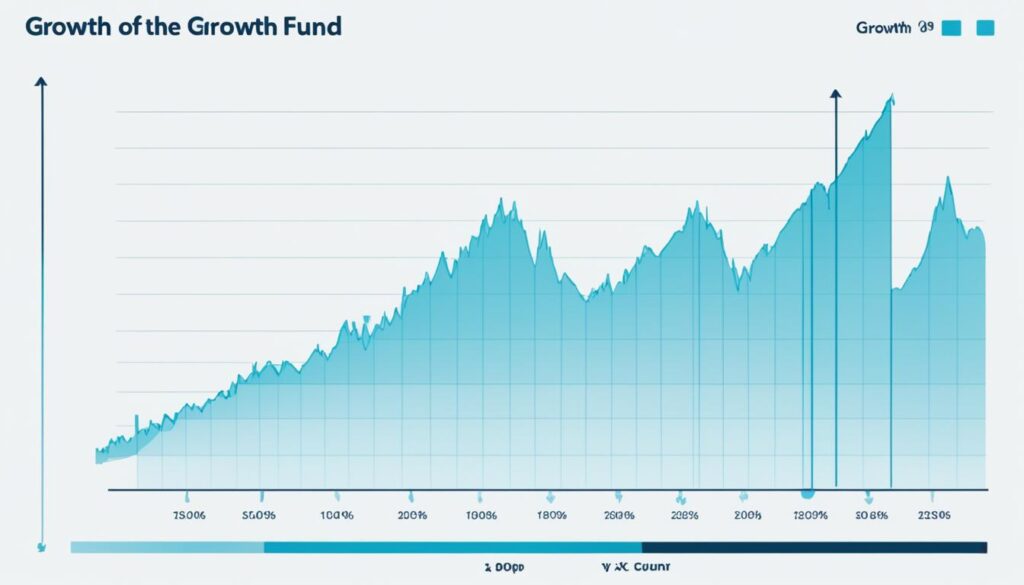A stock market index shows how a part of the market is doing. It’s made up of certain investments. This mix is used to understand how well the market is performing. Examples are the Dow Jones Industrial Average (DJIA), S&P 500 Index, and Nasdaq Composite Index. These help investors follow the market and make decisions about their investments.
Key Takeaways:
- A stock market index is a snapshop of a market segment’s performance.
- Indexes like the DJIA, S&P 500, and Nasdaq Composite are widely used benchmarks.
- Investors use indexes to understand market trends and adjust their portfolios.
- They also help with passive investing, which gives widespread market exposure.
- Knowing about stock market indexes is key in seeing how investments are doing.
Understanding a Market Index
A market index helps investors understand the value of different market segments. It measures the worth of a group of assets with similar market traits. By keeping an eye on these indexes, investors learn about the overall state and direction of market areas.
Each index has its own way of being calculated and supported by the ones who made it. They work hard to make sure the index shows the true performance and features of its assets.
How much each asset affects the index’s overall value is very important. Different indexes use various methods to do this, such as market-cap or price weighting.
Market-cap weighting focuses more on big companies, which have a bigger impact on the market. Meanwhile, price weighting pays closer attention to the movement of high-priced stocks.
The index value is figured out using a special math formula. It involves multiplying the value of each asset by its weight, then adding everything up.
Investors use these indexes to keep track of the financial world and handle their investments better. By watching index performance, they can spot trends and adjust their strategies.
Now, let’s explore some famous indexes and how they work:
Types of Market Indexes
Market indexes are varied, each designed with specific steps. They are important for checking market trends and making investing choices. Now, let’s see the different kinds of market indexes.
1. Market-Cap Weighting
Market-cap weighting is the commonly used method. Here, each index item’s influence is based on its market value. This means big companies have a big effect on the index’s change.
2. Revenue Weighting
Revenue weighting is another approach. The items in these indexes are weighted by their total revenue. This way, companies with more revenue have more pull on the index.
3. Float Weighting
Float weighting looks at shares ready for public trading. It excludes shares not actively trading. More active shares from a company mean it has more weight in the index.
4. Fundamental Weighting
Indexing can also happen by fundamental weighting. Here, factors like earnings and dividends matter more than just the market size. This offers a different way to track a company’s true worth.
Each method has its good points and things to think about. Choosing one depends on what goals investors and index makers have.
Let’s now see a table that shows the main differences in these index-making ways:
| Index Construction Methodology | Key Factors | Advantages | Considerations |
|---|---|---|---|
| Market-Cap Weighting | Market Capitalization | – Reflects market sentiment – Considers the size of the companies |
– Potential concentration in large companies – Market volatility impacts the index more |
| Revenue Weighting | Total Revenue | – Focuses on companies with higher revenue – Provides exposure to top-line growth |
– May overweight companies with low profitability – Susceptible to changes in revenue patterns |
| Float Weighting | Free Float | – Reflects actively traded shares – Limits influence from insider ownership |
– Limited availability of float data – Potential illiquidity for small-cap stocks |
| Fundamental Weighting | Fundamental Metrics (e.g., earnings, book value) | – Considers financial performance – Offers an alternative to market-cap weighting |
– Subjective selection of fundamental factors – Potential biases in factor weighting |
Learning about the different types of indexes helps investors pick the right one for their needs and plans.

Market Indexes As Benchmarks
Market indexes help us compare how well our investments are doing against a standard. They let investors check the returns and risks of their investments. In the U.S., well-known benchmarks include the Dow Jones Industrial Average, S&P 500 Index, and Nasdaq Composite Index.
Each benchmark looks at a different part of the market:
- Dow Jones Industrial Average (DJIA): Follows the 30 leading stocks in the U.S. economy.
- S&P 500: Shows how 500 big U.S. companies perform on the stock market.
- Nasdaq Composite: Keeps track of more than 3,000 stocks on the Nasdaq market.
These market indexes help investors measure how funds, stocks, and managers perform compared to the benchmark. They are key for checking on investment strategies, spotting market trends, and choosing where to put money. Knowing how the benchmark does can give insight into market health and guide investment choices.

Investors use market indexes as benchmarks to follow their investments, check risk, and create varied portfolios. By seeing how their investments do against the benchmark, they learn more about their performance in the big picture.
“Market indexes are like road signs, helping investors in the financial market’s complex world. Tools like the Dow Jones, S&P 500, and Nasdaq Composite help investors understand their choices and make smart decisions.”
| Market Index | Segment |
|---|---|
| Dow Jones Industrial Average (DJIA) | Blue-chip stocks from various sectors |
| S&P 500 | Large-cap U.S. companies |
| Nasdaq Composite | Over 3,000 equities listed on Nasdaq |
Index Funds
Index funds are becoming more favored by both solo and large investors. They follow a market index closely, making them a low-cost path to broad market investing. This saves investors from needing to pick individual stocks or pay high management fees.
These funds work by buying the same stocks as the market index they follow. With this method, investors can enjoy the index’s performance without selecting stocks or changing their portfolios often.
Using an index fund lets investors clearly see how well their investment is doing compared to the market. It gives them a standard to measure against, showing the success of their strategy.
Passive Index Investing
Index funds are central to passive investing in indexes. This method focuses on simple, low-cost approaches to earn returns similar to those of a market index.
It’s based on the idea that market indexes paint a true picture of the market’s health. It’s hard for investors or fund managers to do better than these indexes consistently.
With index funds, investors can easily spread their money across different market areas. This spread helps lessen the risk linked to individual stocks and aims for steady growth over time.
Using index funds for passive investing makes it easy, clear, and affordable to join market trends. It helps in avoiding bad stock picks and market timing risks.
Benefits of Index Funds
Index funds offer multiple pros, drawing in a wide group of investors:
- Low Costs: They usually have cheaper fees than managed funds, saving investors money in the long run. These savings can boost investment returns hugely.
- Diversification: By following a wide market, they spread risk from holding single stocks. This diversification improves the portfolio’s risk and reward balance.
- Consistency: Index funds offer returns that closely track a market index over time. This steady performance is great for long-term investors.
Index funds offer an easy way to get broad market exposure. They are a good choice for those wanting to invest simply yet effectively in various market areas. Plus, they help in tracking performance and making portfolio choices.
Example of Index Fund Performance

Here’s how three popular index funds performed over five years:
| Index Fund | Annualized Return (%) |
|---|---|
| S&P 500 Index Fund | 9.5% |
| Dow Jones Industrial Average Index Fund | 8.2% |
| Nasdaq Composite Index Fund | 11.8% |
The table clearly shows how different index funds can perform, based on the market they follow. It’s useful for investors to make decisions about where to put their money, considering their goals and how much risk they’re willing to take.
Examples of Market Indexes
Market indexes show how parts of the market are moving. They are key tools for understanding market health. Each index looks at different parts like sectors or company sizes. Some top indexes are:
- S&P 500: Follows the top 500 U.S. companies from many areas.
- Dow Jones Industrial Average (DJIA): Shows how 30 big, diverse companies are doing.
- Nasdaq Composite: Looks at 3000+ stocks, mostly tech and growth firms, on Nasdaq.
- S&P 100: Focuses on the top 100 S&P 500 businesses, giving a big picture of large-cap stocks.
There are more indexes for specific parts of the market and particular investment strategies:
- Russell 1000: Features the 1000 largest U.S. firms by market value.
- S&P MidCap 400: Targets companies valued between $2 billion and $10 billion.
- Russell Midcap: Includes around 800 mid-size businesses.
- Russell 2000: For small-cap firms worth $300 million to $2 billion.
- S&P 600: Focuses on 600 small-cap companies.
- U.S. Aggregate Bond Market: Looks at a wide variety of bonds in the U.S.
- Global Aggregate Bond Market: Reviews global bond performance.
All these indexes show the breadth of market analysis tools. They help see how different parts perform in the financial world.
| Index | Description |
|---|---|
| S&P 500 | A benchmark index that includes 500 large-cap U.S. stocks from various sectors. |
| Dow Jones Industrial Average | An index comprising 30 blue-chip industrial stocks. |
| Nasdaq Composite | A market-value-weighted index that reflects the performance of over 3,000 stocks listed on the Nasdaq Stock Market. |
| S&P 100 | An index consisting of the largest 100 companies within the S&P 500, providing insights into large-cap stocks. |
These examples only touch the surface of market indexes. Each one tells us something unique about the market. Indexes are essential for spotting trends and making smart choices in investing.

Index Investing
Index investing is a smart way to improve returns and lower risk in your investment mix. It means putting your money into groups of index funds. This lets you spread your investments across many market parts. You join the market’s growth and avoid putting all your eggs in one basket.
Investing this way helps make your portfolio balanced and safe. Instead of picking single stocks, you spread your money over various index funds. Your mix might include the S&P 500, foreign markets, bonds, and more. This gives you a piece of many areas, making your investments safer.
This strategy also helps manage the level of risk in your investments. By mixing different index funds, you can lower the risk your portfolio faces. For instance, you might mix funds tracking stocks with those tracking bonds. This helps keep your investments stable but still able to grow.
If you have a specific financial goal, like saving for retirement or education costs, index investing can be very useful. Instead of picking stocks one by one, you choose index funds that match what you want to achieve. This reduces the risk of making bad choices and helps you focus on long-term wealth building.
“Index investing provides a low-cost, disciplined approach to investing, allowing individuals to benefit from the overall growth of the market without the need for constant monitoring and active management.” – Financial Advisor Jane Smith
Index investing believes that trying to do better than the market all the time is tough. Those who support it say that active trading often costs more and gives back less. Instead, they trust in the market’s big indexes to show how it’s doing overall.
Thinking about index investing means looking at the costs and results of various index funds. Funds can have different fees, which affect how much money you make. Also, think about how much risk you’re okay with, how long you plan to invest, and what you want to get from your money.
Index investing is a great choice for making your investments widespread and managing risks. By mixing index funds, you work towards both safe and profitable investing. This helps you aim for your financial dreams in the future.
Major Stock Indexes
There are three main indexes for the U.S. stock market. These are the Dow Jones Industrial Average, S&P 500, and Nasdaq Composite.
The Dow is the oldest U.S. stock index. It includes 30 big companies from different sectors. This makes it a key measure of the market’s health.
The S&P 500 is a broader look at the market. It features 500 top companies across various industries. Investors often use this as a yardstick for their investments.
The Nasdaq Composite covers all Nasdaq-listed stocks. It focuses on tech and growth companies like Apple and Amazon. This makes it popular for those interested in the tech sector.
Each index sheds light on different parts of the U.S. stock market. They help us understand market trends and performance.
Comparing the Major Stock Indexes
| Index | Number of Constituents | Weighting Methodology | Main Focus |
|---|---|---|---|
| Dow Jones Industrial Average | 30 | Price-weighted | Blue-chip companies across various industries |
| S&P 500 | 500 | Market-capitalization-weighted | Diverse representation of U.S. stocks |
| Nasdaq Composite | Over 3,000 | Market-capitalization-weighted | Technology and growth-oriented companies |
Indexes in Other Markets
Stock market indexes aren’t the only ones in the financial world. They also track how stocks do. But, they are very important in other places like the bond and mortgage markets.
Bond Indexes
The Bloomberg Aggregate Bond Index is one example. It watches how well investment-grade bonds do. It helps investors figure out if their bond investments are doing well.
These indexes are key for bond investors. They let investors see how the bond market as a whole is performing.
Mortgage Indexes
Mortgage indexes decide adjustable-rate mortgage interest rates. The London Inter-bank Offer Rate (LIBOR) is a famous one. It’s used for setting the rates on lots of financial products, including mortgages.
Following mortgage indexes helps borrowers and lenders alike. They can see how mortgage interest rates are changing. This helps them make good decisions about loans.
Indexes go beyond just the stock market. They offer important clues and benchmarks in many financial markets. This helps investors and others move through these markets well.
Index Funds and Indexed Annuities
Index funds and indexed annuities are two ways to invest in the stock market. Both let investors share in market growth. Index funds mirror the performance of market indexes. They offer a wide range of market securities. This diversifies a portfolio without needing to pick individual stocks.
Indexed annuities track specific trading indexes. They give a return based on index performance. These annuities have return caps, limiting upsides but ensuring stability. This makes them attractive to conservative investors.
Index funds and indexed annuities have different levels of risk and return. Index funds provide direct market exposure. They may offer higher returns based on the index’s performance. Indexed annuities, however, balance potential upsides with protection against downturns.
Investors should consider risk tolerance and goals when choosing between these options. Some may like index funds’ flexibility and potential for better returns. Others might prefer the safety and guaranteed returns of indexed annuities.
| Index Funds | Indexed Annuities |
|---|---|
| Investment vehicle that replicates the performance of a specific market index | Financial product tied to a specific trading index |
| Direct exposure to market segments | Participate in the growth of market segments |
| Potential for higher returns | Cap on returns, limiting potential upside |
| Lower level of downside protection | Stability and guaranteed minimum returns |
| More suitable for investors with higher risk tolerance | More suitable for conservative investors |
The Importance of Rate of Return and Market Segments
Rates of return and market segments are key to both index funds and indexed annuities. The rate of return is your investment gain or loss over time. It’s vital to look at historical trends and future market movements. This helps investors pick the best market segments and investment options.
Market segments are unique parts of the financial market. They cover different industries, classes, or regions. Each segment has its own risk and return traits. Investors can put their money where it grows most. This aligns their investments with strong market opportunities and cuts risks.
Conclusion
The stock market index is a key tool in finance, showing how well investments are doing. It reflects the market’s movement. This helps investors check their portfolios wisely. Using index funds or passive investing, people get access to many market sections. This lets them earn more and lower risks.
Comparing your investments with the right indexes is critical for knowing how you’re doing. This way, you see if your investments are keeping up with the market. It shows where you’re strong or weak. And helps you plan for the future.
Stock market indexes help investors see how their money is doing. They give a guide for making smart choices. With their help, anyone can do better in finance. Understanding these indexes is key for success in investing, no matter your experience level.
FAQ
What is a stock market index?
A stock market index is like a make-believe collection of investments showing part of the financial world. It gives a general view of investments in that sector. People use it to see how well or badly that part of the market is doing.
How is a market index calculated?
There are different ways to calculate each market index. The index provider figures this out and then keeps it up to date. These calculations use special math based on the total value of the investments.
What are the different types of market indexes?
Market indexes can be made in different ways. The most common way is to base it on the size of the companies in the index. Other types look at the company’s sales, the number of their available stock shares, or their overall financial health.
How are market indexes used as benchmarks?
Market indexes serve as goals to measure an investment’s success. The Dow Jones, S&P 500, and Nasdaq are well-known examples. These are like report cards showing how well managers or funds are doing compared to the market.
What are index funds?
Index funds try to match a specific market index’s overall performance. They’re a good, low-cost way for people to invest in the market without picking stocks. These funds buy the same stocks as the index they follow.
What are some examples of market indexes?
The S&P 500, Dow Jones, and Nasdaq are some of the biggest indexes. They show how different parts of the market are doing. This helps investors know about the market’s health and trends.
Why should I consider index investing?
Index investing is a smart way to manage risk and see good returns. By investing in a mix of index funds, you spread out your money in the market. This strategy works on the idea that the market as a whole does well over time.
What are the major stock indexes in the United States?
In the U.S., major indexes include the Dow Jones, S&P 500, and Nasdaq. They give an overview of different parts of the U.S. stock market. Investors often use them to compare their investment performance.
Can indexes be used in other markets?
Index use is not just for stocks. In the bond market, you have the Bloomberg Bond Index. For mortgages, the LIBOR sets interest rates based on the financial market’s performance.
What is the difference between index funds and indexed annuities?
Index funds track the overall market and offer a broad investment. Indexed annuities link to specific indexes and limit how much you can earn from them. They aim to give returns based on their index’s performance.
Why are stock market indexes important?
Stock indexes are key benchmarks in finance. They show how investments are doing and give clues about the market’s status. Investors use them to see how well their investments match the market. This helps them understand their investment’s real performance.


















